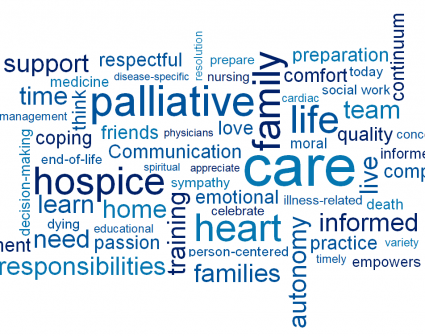Laurie's Blogs.
Jan 2021
Palliative Care Physiotherapy

I’ve been messaging back and forth with a UK animal physio about a case that turned out to be a nerve sheath tumour. The most recent round of discussion has been about treatment now that the diagnosis has been established. The diagnosing veterinarian told the owner to stop physiotherapy as it wouldn’t be of any benefit. Shame! My suggestion is palliative care if the owners are interested and willing in nurturing quality of life until a time when euthanasia becomes the next humane treatment option.
Physiotherapy is a huge field of ever-expanding practice areas (in which to dabble or to specialize). For example, the Canadian Physiotherapy Association recognizes 14 different specialized divisions – orthopaedics, neurology, sports, cardiorespiratory, global health, paediatrics, senior’s health, pain science, leadership, private practice, women’s health, acupuncture, oncology, and my favourite, animal rehabilitation. Then each one of these further branches down from there and then there some areas of practice don’t really know where to fit in (i.e. vestibular rehab, burns and wounds). All in all, ‘physiotherapy’ is much, much bigger than what is taught in canine (or equine) rehab programs. And PALLIATIVE PHYSIOTHERAPY is one area that needs a bit more attention in canine rehab circles.
Physiopedia defines palliative physiotherapy the following way: “Palliative care is a practice discipline, which involves progressive and life-limiting illnesses such a cancer, chronic obstructive pulmonary disease, motor neurone disease [MND] and multiple sclerosis, each of which can benefit from the involvement in physiotherapy. Providing pain relief and management of distressing and debilitating symptoms, palliative care improves quality of life (QoL) for patients with a life-limiting illness, and their families. Helping integrate the psychological, social and spiritual aspects of holistic care, palliative care manages patients’ symptoms and pain levels, providing relief from distress and ultimately, facilitating improved function.”1
I challenge you to google Palliative Care Physiotherapy and see just how much comes up! I love that the definition above uses term that is near and dear to every physiotherapist – FUNCTION. So much of what we do is about improving or maintaining function!
Now, bear in mind that palliative is not just about ‘end of life’, but about quality of life. I found another wonderful descriptive: “The purpose of palliative care is to address symptoms such as pain, breathing difficulties, or nausea, among others. Receiving palliative care does not necessarily mean you're dying. Palliative care gives you a chance to live your life more comfortably.”2
Let’s look at some Palliative examples to help discern the problem lists for each in order to brainstorm how canine physiotherapy & rehab can help the palliative canine patient.
The Cancer Patient.
Potential Problem List: Pain. Weakness. Side effects from other treatments. Lymphedema. Reduced functional capabilities. Fatigue. Owner’s stress or depression.
The Cushing’s Patient.
Potential Problem List: Inactivity. Weakness. Bone brittleness (in people). Increase thirst (and urination). Skin infections. Panting.
Degenerative Myelopathy.
Potential Problem List: Progressive neurologic weakness. Compensatory pain or dysfunction. Pressure sores. Bowel and bladder dysfunction.
Spinal Cord Injuries.
Potential Problem List: Weakness and/or paralysis. Compensatory pain or dysfunction. Pressure sores. Loss of bowel and bladder control.
Blind dogs.
Potential Problem List: Less active. Fear of moving. Clumsiness.
Therapies at our disposal: Therapeutic exercise (for function and mood), massage (to treat pain and anxiety), lymphatic drainage, passive ROM, and other manual therapies, modalities for pain relief (i.e. PEMF or Laser… both of which have been shown to be HELPFUL in treating cancer invivo, and may also help with pain. Laser may also help to slow the progression of degenerative myelopathy), wound healing, advice or education on home adaptations to facilitate better function (i.e. harnesses, a wheelchair, booties, ramps, non-slip rugs, positioning strategies, bowel and bladder management strategies, home therapies, etc.), problem solving for unique situations and direction to unique tools or strategies), education and emotional support for the owner, and social interaction for the dog.
All in all, palliative rehabilitation is often overlooked in small animal care. It’s a shame because there is so much that we can do. So much that the owners can do. And so much that we can share with the owners and help them to continue to love their pets for longer.
To end, I will steal a quote from a fellow physiotherapist, Sarah MacKeigan who runs a BRILLIANT Facebook page (that I have started to recommend to many of my clients - https://www.facebook.com/groups/LivingwithDogswithDisabilities), “It’s not over. It’s just different.”
References:
1.Physiopedia. Physiotherapy in Palliative Care. https://www.physio-pedia.com/Physiotherapy_in_Palliative_Care (Accessed Dec 30, 2020).
2.National Institute of Nursing Research. Palliative Care. The relief you need when you have a serious illness. September 2020. https://www.ninr.nih.gov/sites/files/docs/palliative-care-brochure.pdf
3.Physiopedia. Cushing’s Syndrome. https://www.physio-pedia.com/Cushing%27s_Syndrome (Accessed Dec 30, 2020).
4.Weir M, Ward E. Cushing’s Disease in Dogs. https://vcahospitals.com/know-your-pet/cushings-disease-in-dogs (Accessed Dec 30, 2020).
5.Hunter T, Ward E. Degenerative Myelopathy. https://vcahospitals.com/know-your-pet/degenerative-myelopathy-in-dogs (Accessed Dec 30, 2020).
6.Jamieson A. 18 Helpful Tips for Caring for a Blind Dog. Nov 14, 2018. https://www.care.com/c/stories/6299/17-tips-for-living-with-a-blind-dog/


